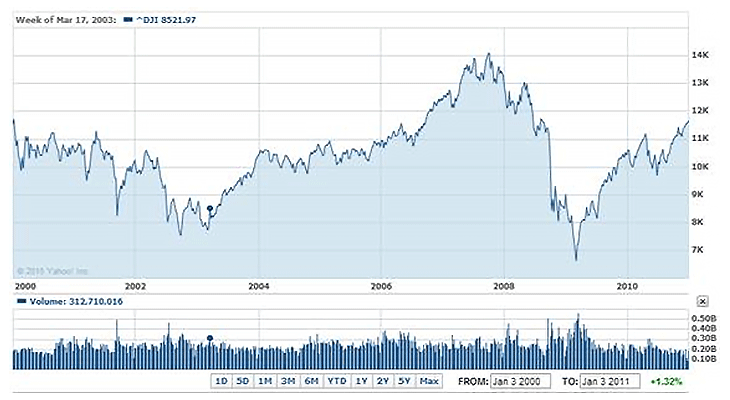For many retirees, one of the first investment strategies they likely ever heard was the ‘buy-and-hold’ approach to investing. You will likely remember this simple concept – people purchase investments and hold them for an extended period of time, riding through the ‘ups and downs’ of the market. Investors are assured not to worry about the peaks and valleys because over the long term, the value of the stock will go up. It’s a very passive strategy and can work very well in good markets. But in difficult markets, it doesn’t always work.
Markets Are Increasingly Volatile
Times have changed and markets today are increasingly volatile. Good active management tends to outperform passive management in difficult and volatile markets. Let’s take a closer look at an example to show the differences.
If you look at the performance of the DOW Jones Industrial Average from 2000 to 2010 – a span of 10 years – you’ll notice that the DOW passed the 10,000 point mark at least six times.

source: Yahoo Finance
Thus investors that owned stocks in the DOW or owned the DOW Jones ETF itself and followed the ‘buy-and-hold’ approach, would have seen very little positive results during that period of time. The index unfortunately, didn’t move much higher.
Whereas, active investors could have seen much better results. If investors bought quality investments and then set price targets of when to sell, could have done very well. By selling part or all of their investments when they reached their targets, investors would have realized capital gains. It’s never a bad idea to sell and make a profit.
By actively managing your portfolio, it sometimes can make sense to sell an investment at a loss as well, to reinvest the proceeds into something else that will move quicker to the upside.
To do this effectively, it’s often best to work with an investment advisor, who can help you make informed decisions. You’ll want to work with an advisor who follows and understands the markets.
Managing In Volatile Markets
In these increasingly volatile markets, there are some simple steps that retirees can take to protect their portfolio’s.
Investors can take several steps to ensure their money is protected while maximizing growth:
Look to leaders – Identify current economic trends where the “smart money” is being invested. In times of distress, look to large companies … leaders in their industry. These companies tend to outperform in good times and help cushion a portfolio against losses when times are tough.
Get paid to wait -Companies that pay dividends tend to outperform over the longer term. Companies that continue to increase the amount of dividends they pay will provide some growth while you wait for the stock’s share price to rise.
Shop for bargains – Smart investors look for investments that are “cheap” by historical standards and trade at low multiples. Many investors look to the P/E ratio (price of the stock versus its earnings) as a measuring stick to find good valued growth investments.
Reduce cost of investing – Depending on the size of a portfolio, investors may consider having their own specifically tailored mutual fund created out of individual securities in a fee-based scenario. Fee-based accounts can cost less than managed products, such as mutual funds, and their annual fees may be tax deductible. This keeps more money in your hands and can cushion a portfolio in difficult times.
Investing in quality companies that pay consistent dividends and are inexpensive is the best way to protect your money today and grow it over time.
Call Me or Email Me
My retired clients continue to benefit from the diversified portfolios I create for them. Call me at 416-332-3863 or email me at allan@allansmall.com to discuss how your portfolio can grow during retirement.

